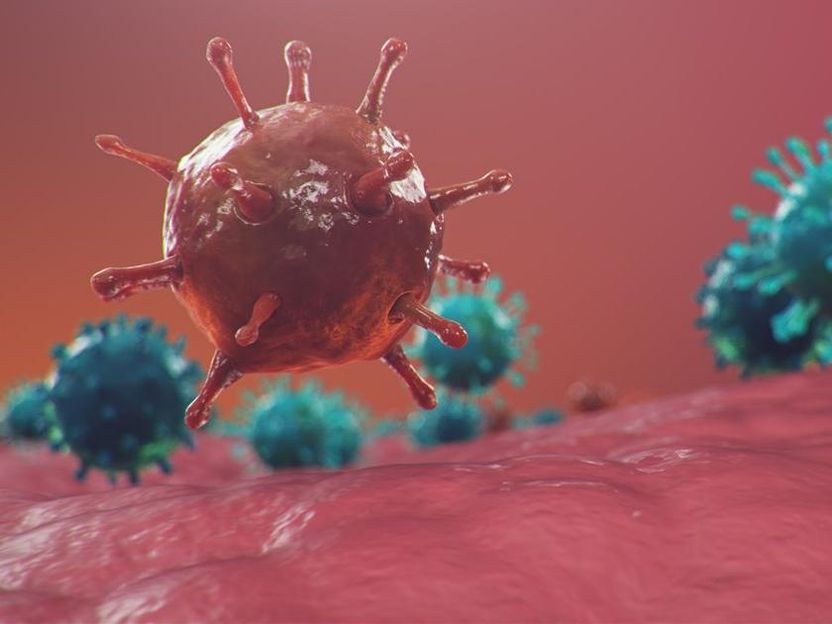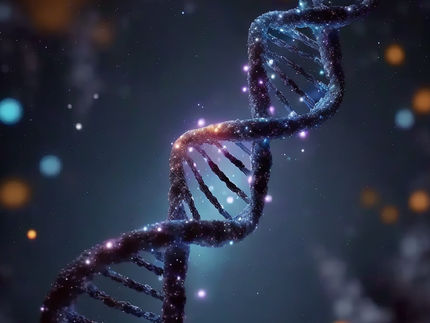Omicron mutations already existed in infected patients months before becoming dominant.
An ultra-deep sequencing technique for detecting viral sequences undetectable by standard methods
CSIC researchers, in collaboration with the Fundación Jiménez Díaz, have discovered that patients vaccinated and infected with the alpha variant during the third wave of the covid19 pandemic (between January and March 2021) already had mutations characteristic of the delta plus, iota and omicron variants. This interdisciplinary study, published in the Journal of Clinical Investigation, has analyzed in detail for the first time in Spain nasopharyngeal swab samples from patients vaccinated and subsequently infected during the third wave of the pandemic.

Recreation of SARS-Cov-2 infection.
Creative Commons
This study has been possible thanks to previous work on the development of a powerful ultra-deep sequencing methodology that allows the detection of mutated viral sequences found in very low proportions that are not detectable by the usual shallow sequencing techniques. "From each sample analyzed and from each piece of virus analyzed we obtain many thousands of sequences. This allows us to detect mutations at different frequency levels coexisting within the infected patient," explains Celia Perales, a researcher at the National Center for Biotechnology (CNB-CSIC) and the Institute for Health Research of the Fundación Jiménez Díaz.
The results have revealed that although the patients were infected with the alpha variant, predominant at that date (between January and March 2021), changes corresponding to the delta plus, iota and omicron variants were already present in these samples months before they acquired epidemiological relevance.
"This work highlights the need to analyze virus populations with high resolution and in depth to obtain a joint vision of the many mutants that coexist in each infected individual," emphasizes Esteban Domingo, researcher at the Severo Ochoa Molecular Biology Center (CBMSO-CSIC-UAM). These analyses could make it possible to monitor potentially relevant mutations, or sets of mutations, before they become part of dangerous variants.
Note: This article has been translated using a computer system without human intervention. LUMITOS offers these automatic translations to present a wider range of current news. Since this article has been translated with automatic translation, it is possible that it contains errors in vocabulary, syntax or grammar. The original article in Spanish can be found here.
Original publication
B Martínez-González, L Vázquez-Sirvent, M E Soria, P Mínguez, L Salar-Vidal, C García-Crespo, I Gallego, A Il de Ávila, C Llorens, B Soriano, R Ramos-Ruiz, J Esteban, R Fernandez-Roblas, I Gadea, C Ayuso, J Ruíz-Hornillos, C Pérez-Jorge, E Domingo, C Perales; "Vaccine-breakthrough infections with SARS-CoV-2 Alpha mirror 3 mutations in Delta Plus, Iota and Omicron."; Journal of Clinical Investigation 2022.
Most read news
Original publication
B Martínez-González, L Vázquez-Sirvent, M E Soria, P Mínguez, L Salar-Vidal, C García-Crespo, I Gallego, A Il de Ávila, C Llorens, B Soriano, R Ramos-Ruiz, J Esteban, R Fernandez-Roblas, I Gadea, C Ayuso, J Ruíz-Hornillos, C Pérez-Jorge, E Domingo, C Perales; "Vaccine-breakthrough infections with SARS-CoV-2 Alpha mirror 3 mutations in Delta Plus, Iota and Omicron."; Journal of Clinical Investigation 2022.
Organizations
Other news from the department science

Get the life science industry in your inbox
By submitting this form you agree that LUMITOS AG will send you the newsletter(s) selected above by email. Your data will not be passed on to third parties. Your data will be stored and processed in accordance with our data protection regulations. LUMITOS may contact you by email for the purpose of advertising or market and opinion surveys. You can revoke your consent at any time without giving reasons to LUMITOS AG, Ernst-Augustin-Str. 2, 12489 Berlin, Germany or by e-mail at revoke@lumitos.com with effect for the future. In addition, each email contains a link to unsubscribe from the corresponding newsletter.





















































